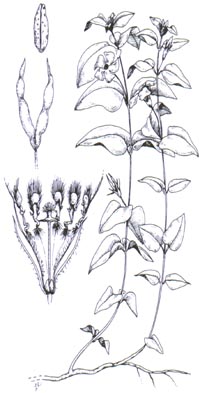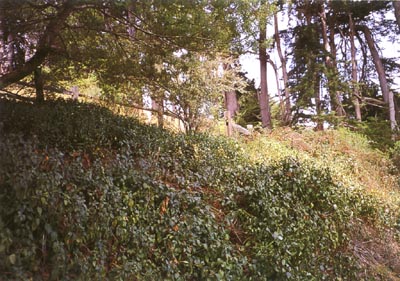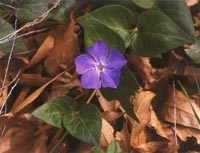|
Vinca major
|
|
|
|
Scientific name
|
Vinca major
|
|
Additional name information:
|
L.
|
|
Common name
|
periwinkle, bigleaf periwinkle
|
|
Synonymous scientific names
|
none known
|
|
Closely related California natives
|
0
|
|
Closely related California non-natives:
|
0
|
|
Listed
|
CalEPPC List B,CDFA nl
|
|
By:
|
Jennifer Drewitz
|
|
Distribution
|
|
|
HOW DO I RECOGNIZE IT?
Distinctive features:
|
Periwinkle (Vinca major
) is a spreading perennial vine with glabrous, dark green stems that contain a milky latex. The non-flowering stems grow close to the ground, rooting at the nodes and extending outward to three feet. Flowering stems grow erect to knee-high with solitary flowers developing in the leaf axil (Bean and Russo 1986). The purplish-blue flowers have five equal petals fused at the base. Five stamens attach near the top of the corolla tube, which is hairy within. |

vinca-illus
|
|
åÊ
|
|
Description:
|
Apocynaceae. Stems: non-flowering stems
prostrate; flowering stems erect to 0.5-1.5 ft (15-45 cm). Leaves: to 2-3 in
(5-7.5 cm) long, covered with a waxy cuticle, cordate at base, tapering to acute
apex. Leaves opposite, 4-ranked; entire margins covered by ciliate hairs (Bean
and Russo 1986). Petioles nearly glabrous,
åÊ
|
|
WHERE WOULD I FIND IT?
|
PeriwinkleÛªs range extends from California
throughout the southern United States. In California it is found up to 610 feet
(200 m) elevation in most coastal counties, the Central Valley, and desert
areas. It prefers a mediterranean climate and frost-free, damp, shaded soils
(Stern 1973). It has been observed thriving along tree-covered drainages and
creeks in coastal areas (Alvarez 1997). It has escaped from gardens and old
homesteads where it has been used as an ornamental groundcover and is commonly
found spreading from moist roadside locations where it has been dumped (Bean and
Russo 1986).
åÊ
|
|
WHERE DID IT COME FROM AND HOW IS IT SPREAD?
|
Originally from southern Europe and northern
Africa, periwinkle was introduced to the United States as an ornamental
groundcover and medicinal herb (Schittler 1973). It spreads vegetatively and is
not known to reproduce sexually in California (Bean and Russo 1986). Water can
transport broken stem fragments throughout riparian zones, where the plantÛªs
ability to resprout enables it to spread rapidly. The rate of spread is not
documented in the literature, but it appears to be limited by shade and moisture
requirements.
åÊ
|
|
WHAT PROBLEMS DOES IT CAUSE?
|
Once established, periwinkle forms a dense
cover that prevents growth and establishment of other plant species (Stern
1973). Periwinkle lowers species diversity and disrupts native plant
communities. Riparian zones are particularly sensitive. Major infestations at
The Nature ConservancyÛªs Ramsey Canyon Preserve in southern Arizona have
suppressed natural erosional processes in a creek, promoting deepening and
scouring of the creek bed and altering local hydrology and vegetation (McKnight
1993).
åÊ
|
|
HOW DOES IT GROW AND REPRODUCE?
|

vinca-large2
|
(click on photos to view larger image)
|
In California periwinkle reproduces vegetatively, not by seed. When produced, seeds rarely mature, and gardeners propagate it by cuttings. The plant spreads by sprawling stems that form a shallow root at the nodes. This creates a carpet of vegetation. The flowers begin to bloom in March and continue into July. Wet periods rapidly
|
|
accelerate vegetative growth. Periwinkle will die back in a frost, but
will resprout when optimal conditions return. It does not grow well in dry soil
or direct sunlight, but does well in a moist microclimate with shaded areas
(Stearn 1974).
|
|
Physical control:
|
Manual/mechanical methods: Hand removal is
labor-intensive, but yields good results if careful attention is paid to
removing all root nodes and stolons. In Ramsey Canyon, Arizona, volunteers
successfully cleared four acres using hand removal over a three-year period. An
effective method is to work inward from the perimeter of the patch and pull the
periwinkle back in on itself to prevent further spread of the weed between
removal sessions (TNC 1997). Repeated removal efforts, scheduled over a growing
season, may allow natives to recolonize the area and reduce the chance that
other weeds will move into the area following the disturbance caused by removal
activities (Mcknight 1993).
Because periwinkle has the ability to resprout, mowing or
cutting results in abundant regrowth and is not recommended (TNC
1997).
åÊ
|
|
Biological control:
|
Biocontrol agents have not been determined
or tested for Vinca major.
åÊ
|
|
Chemical control:
|
Glyphosate (as Round upå¨) has been tested on
large infestations of periwinkle at Ramsey Canyon, Arizona. Greatest success is
achieved if plants are cut first and then sprayed immediately afterward. Cutting
with a weed whip or brush cutter breaks through the waxy cuticle and allows
better foliar penetration of the herbicide. Using the cut and spray method, a 5
percent glyphosate solution gave nearly 100 percent control. To reduce native
plant death in the area, a 3 percent solution provides 70-75 percent control and
yields good results if followed by spot applications (Bean and Russo 1986). A
wick applicator is suggested for spot treatments, and a backpack sprayer is
recommended for treating large areas. To aid chemical distribution throughout
the plant, use surfactant and apply herbicide during an optimal growing period
of good moisture and warm temperatures (70-80 degrees F) usually in late spring
or early fall.
Monitoring is recommended. Follow-up on any
removal actions is necessary, as any overlooked stem or plant fragments will
quickly resprout. Following chemical removal, the population should be checked
twice, in early fall and late spring. With manual removal, follow-up should be
performed every three months to remove resprouts. After the patch is eradicated
it should be checked twice a year in optimal growing seasons.
åÊ
|




